Primax Electronics RO07UOA Wireless Mouse User Manual
Primax Electronics Ltd Wireless Mouse Users Manual
Users Manual

- 1 -
FCC Statement
This device complies with part 15 of FCC Rules. Operation is subject to the following two
conditions: (1) this device may not cause harmful interference, and (2) this device must accept
any interference received, including interference that may cause undesired operation.
This equipment has been tested and found to comply with the limits for a Class B digital device,
pursuant to part 15 of the FCC Rules. These limits are designed to provide reasonable protection
against harmful interference in a residential installation. This equipment generates, uses and can
radiate radio frequency energy and, if not installed and used in accordance with the instructions,
may cause harmful interference to radio communications. However, there is no guarantee that
interference will not occur in a particular installation. If this equipment does cause harmful
interference to radio or television reception, which can be determined by turning the equipment off
and on, the user is encouraged to try to correct the interference by one or more of the following
measures:
• Reorient or relocate the receiving antenna.
• Increase the separation between the equipment and the receiver.
• Connect the equipment into an outlet on a circuit different from that to which the receiver is
connected.
FCC Caution: To assure continued compliance, (example – use only shielded interface cable
when connecting to computer or peripheral devices). Any changes or modifications not expressly
approved by the party responsible for compliance could void the user’s authority to operate this
equipment.
Copyright
Copyright 2001 Primax Electronics Ltd. All rights reserved. No part of this publication may be
reproduced, transmitted, transcribed, stored in a retrieval system, or translated into any language
or computer language, in any form or by any means, electronic, optical, mechanical, magnetic,
chemical, manual, or otherwise, without the prior written permission of Primax Electronics Ltd.
Trademarks
Primax is a registered trademark of Primax Electronics Ltd. All other trademarks used in this
documentation are the sole property of their respective owners.

- 2 -
Installing Your Mouse
1. Hardware Installation
To connect your PS/2 Mouse
Note: Before coneect the mouse to your system, please make sure your computer is off.
1. Turn off your computer.
2. Connect the mouse cable to the PS/2 (6-pin) mouse port.
3. Turn on the computer.
To connect your USB Mouse
Note: To use the USB mouse, you need to have Windows 98 / ME / 2000 / XP (recommended)
installed on your computer.
1. You don’t need to turn off your computer before connect your USB mouse.
2. Plug the rectangular USB mouse connector into the USB port (normally in the back of the
PC).
3. Insert the software diskette into your disk drive and follow the onscreen instructions to install
the device driver.
2. Installing MouseSuite™ Software
Important: If you are installing your mouse on a Windows NT / 2000 / XP system,
please make sure you log in with Administrator right before proceeding.
The Mouse Suite™ Software must be installed in order to use all of the features of your
new mouse. Please use the following guide to properly install the Mouse Suite™ software.
1. Start Windows and insert the Mouse Suite™ installation software into the appropriate drive.
2. Click Start on the Task Bar and select Run.
3. From the Run dialog box, enter: <drive>:\Setup, and click OK. For example, if the setup disk
is in drive A, type a:\setup.
4. Follow the on-screen instructions to complete the software installation.

- 3 -
Using the Wheel
Note: This section is for wheel mouse only.
Your new mouse may have a wheel that can be used in two ways:
• Rotate it to use it as the wheel.
• Click it to use it as the wheel button.
After successful installation, the Wheel Mouse will offer the following features to make
your life or work much easier.
Scrolling
The Wheel on your mouse can be used to scroll through most applications with scroll
bars.
• To scroll with your Mouse, simply move the wheel on the mouse forward or backward.
AutoScrolling
AutoScroll allows you to automatically scroll through a document without having to move
the mouse or mouse wheel constantly.
• To use AutoScroll while in a document, click the button that was designated as AutoScroll. An
origin mark ( ) will appear at your pointer position. To start AutoScrolling, move your
pointer vertically, horizontally, or diagonally away from the origin mark. AutoScroll speed
increases as the pointer is moved away from the origin mark. To stop AutoScrolling, press
any mouse button or rotate the wheel.
Zooming
In some Office 97 compatible applications (e.g. Microsoft Word 97), additional zooming
functions are available. You can use the zooming function to “zoom in” for a closer look
at a page or “zoom out” to see more of a page.
• To zoom in, hold the Ctrl key down and rotate the mouse wheel forward.
• To zoom out, hold the Ctrl key down and rotate the mouse wheel backward.
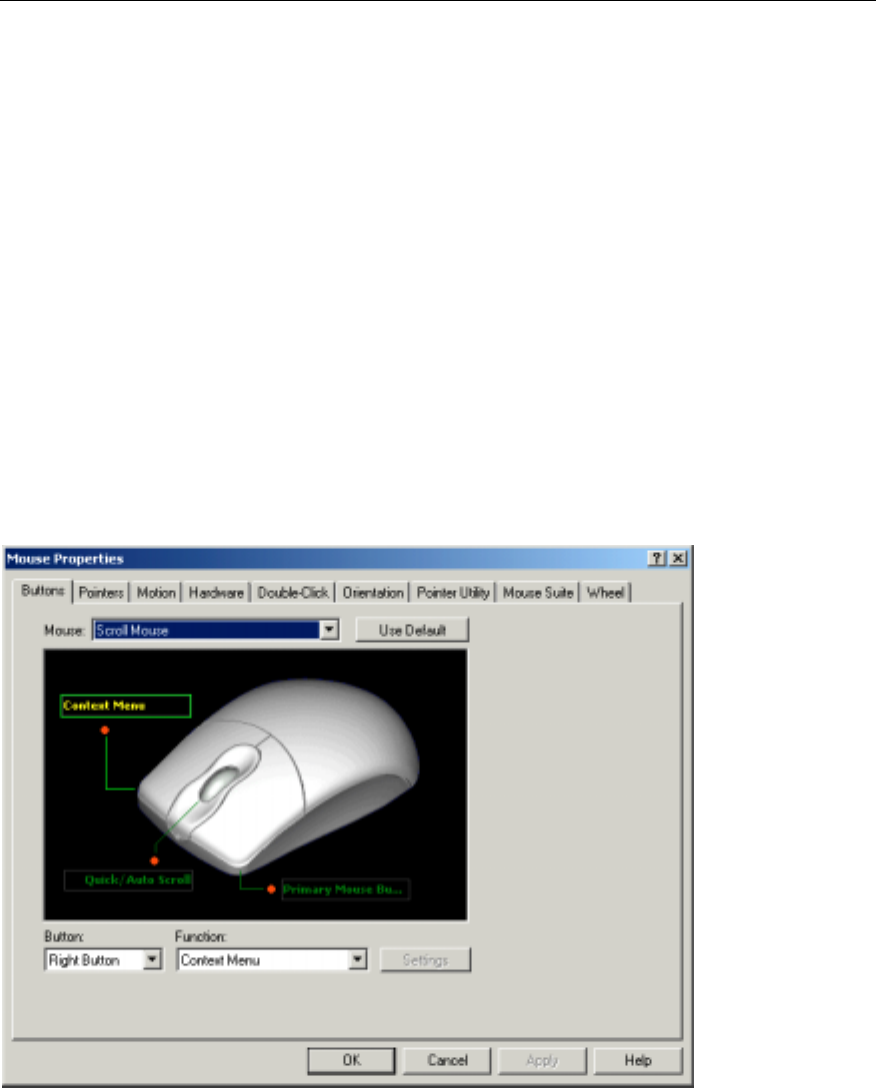
- 4 -
Mouse Suite™ Control Panel
Mouse Suite™ comes with a Mouse Control Panel that lets you manage all the functions
of your new mouse.
To find your Mouse Control Panel, follow these steps:
• On computers running Windows 95, Windows NT4.0 (and above) or Windows 98, click the
Start button. Click on Control Panel under the Settings menu. Now double-click on the
Mouse Icon.
-Or-
If you have already enabled on the Show Mouse Icon in Task Bar option in the Mouse Suite
page of the Mouse Properties, simply double-click on the Mouse Icon in the Windows Task
Bar.
The Mouse Properties Tabs
Mouse Suite™ offers a lot of extra functions that can be accessed within the Mouse
Properties by clicking on the respective Tab.
Buttons
Accessing the Buttons page allows you to customize the function of each mouse button.
The default settings for your mouse buttons are as follows:
• Left Button Primary Mouse Button (standard click and drag action)
• Middle Button Quick / Auto Scroll
• Right Button Context Menu / Alternate Select
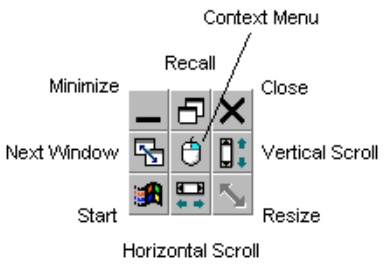
- 5 -
To change the configuration of your mouse buttons, follow these steps:
1. On the Mouse Image, click on the button you want to assign a new function to, or select a
button from the Button list. The selected button will be displayed in the Button list and
highlighted on the mouse image.
2. Next, select a function from the Function list (at least one mouse button must be designated
as the Primary Mouse Button).
3. To reset your mouse buttons to the default setting, click on Use Default.
4. To confirm your button settings, click on Apply.
Special Button Functions
HyperGrid
HyperGrid incorporates nine common Windows tasks on one easy to use grid so you don’t have to
move to various screen areas to perform a task.
• Assign HyperGrid using the same procedure for standard button functions.
• To use the HyperGrid, press and hold the assigned mouse button to display the grid. Without
releasing the button, move the pointer to an icon on the grid. Release the button to execute
the command associated with that icon.
Minimize Minimizes the active window.
Recall Restores / maximizes the active
window.
Close Closes the active window.
Next Window Makes the next window active.
Context Menu Emulates the right mouse button
to open the context menu.
Vertical Scroll Performs the vertical scrolling
function.
Start Opens the Windows Start menu.
Horizontal Scroll Performs the horizontal scrolling
function.
Resize Jumps to the size grip to resize
the active window.
HyperLink
With HyperLink designated as a button function, you can open the application or document of your
choice with a simple click.
• First, specify a button in the Button list.
• To shortcut to applications or documents not available from the Function list, select
HyperLink from the Function list.
• Next, click on Settings. Click on Browse to search for and select a suitable shortcut.
• Click on OK to confirm your selection.
• To use HyperLink, simply click the assigned mouse button.
Magnifier
With Magnifier designated as a button function, you can magnify the screen area around your
pointer with a click of the assigned button.
• First, specify a button in the Button list.
- 6 -
• Next, assign Magnifier to that button by selecting it from the Function list.
• Now, click on Settings to adjust the size, shape and power of the magnifier.
• Click on OK when finished.
• To use the Magnifier, simply click the assigned mouse button.
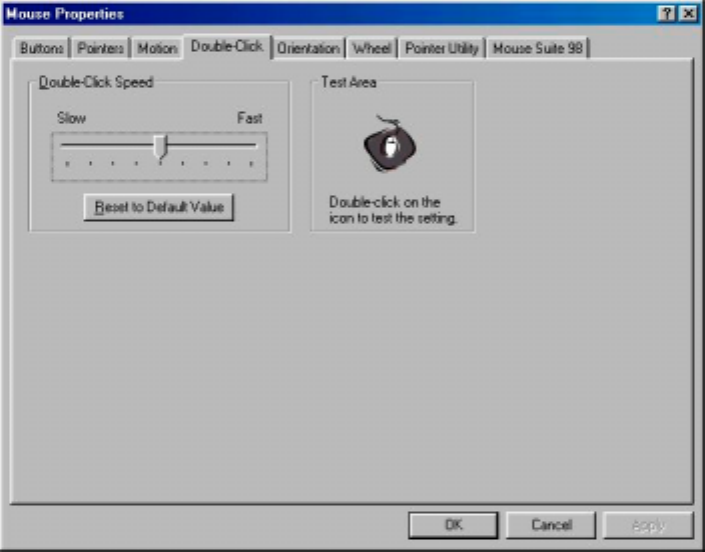
- 7 -
Double-click
The Double-click feature allows you to change the speed at which your software
applications will respond to a double-click of the mouse button.
• To adjust the double-click speed, click and drag the Slider left (slower) or right (faster).
• To test double-click speed, double-click on the image in the test area.
• Reset the double-click speed setting by clicking on Reset to Default Value.
• To confirm your double-click speed setting, click on Apply.
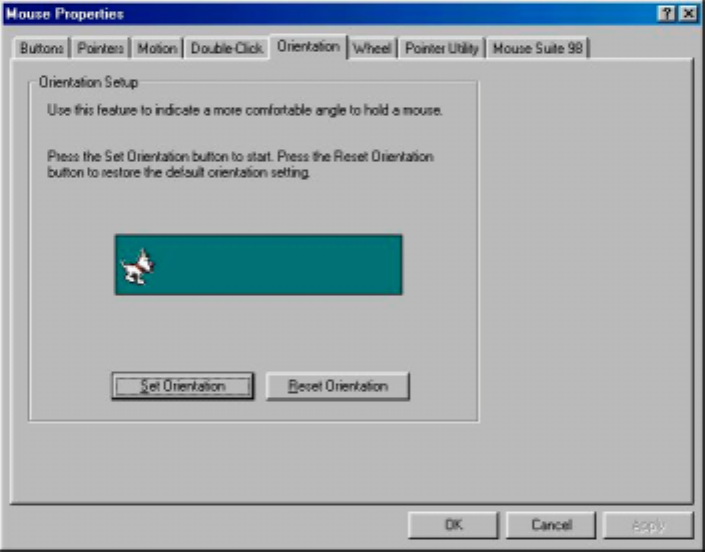
- 8 -
Orientation
The Orientation tab allows you to redefine the horizontal axis of your mouse so you can
use it in your preferred position.
• To change the orientation of your mouse, click on the Set Orientation button and follow the
on-screen instructions.
• To restore the default orientation status, click on the Reset Orientation button.
• To confirm your orientation settings, click on Apply.
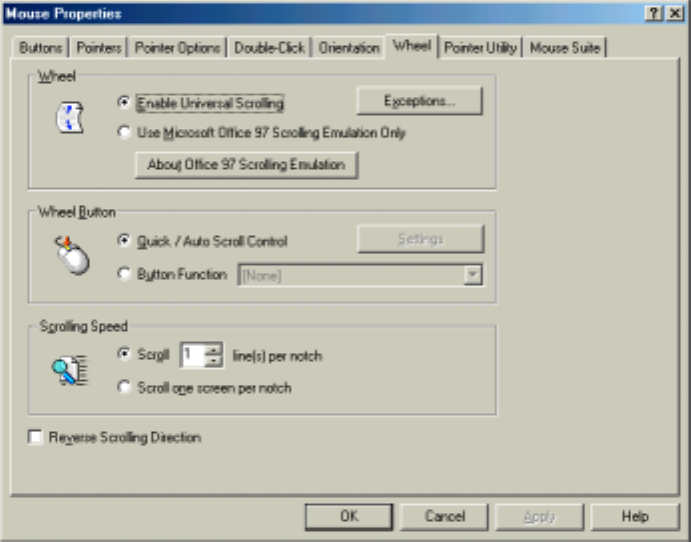
- 9 -
Wheel
The Wheel tab lets you configure the scrolling settings of the wheel on your mouse.
Wheel
Mouse Suite offers Universal Scrolling, designed to work with most applications with standard
scroll bars, including applications that are not compatible with Office 97 scrolling standard (e.g.
WordPerfect 7.0, Netscape Navigator 3.0, and Microsoft Office 95, etc.). While in Universal
Scrolling mode, the mouse will still perform the zooming functions available in Microsoft Office 97
if you press the CTRL key at the same time.
While in Universal Scrolling mode, if you wish to use the Office 97 scrolling emualtion in some
Office 97 compatible applications, you can specify those applications by using the Exceptions
button.
Instead of the powerful Uninversal Scrolling feature, you may select the Office 97 Scrolling
Emualtion Only option. However, the scrolling functions will be restricted to Microsoft Office 97
compatible applications (e.g. Microsoft Internet Explorer 3.0/4.0). To learn more about the Office
97 Scrolling Standard, click on About Office 97 Scrolling Emulation.
• To enable Universal Scrolling, select Enable Universal Scrolling, then click on Apply.
• To use the pure Office 97 scrolling emulation, select Use Microsoft Office 97 Scrolling
Emulation Only, and click on Apply.
• To specify an exception application, click on the Exceptions button. Next, click the Add
button. Specify an application by typing its program path (e.g. c:\ie4\iexplorer.exe) or browse
for applications by clicking on the Browse button. You can also use the Magnifying Glass
tool to specify an application. Click, hold, and drag the Magnifying Glass tool to an open
window of the application you want to add as an exception. Release the mouse button and
- 10 -
the application will appear in the Program Path text area. To remove an exception, select the
application you wish to remove from the exceptions list and click on Remove. Click on OK to
confirm.
Wheel Button
Allow you to change the configyuration of you wheel button.
Scrolling Speed
Allow you to change the scrolling speed in response to the wheel movement.
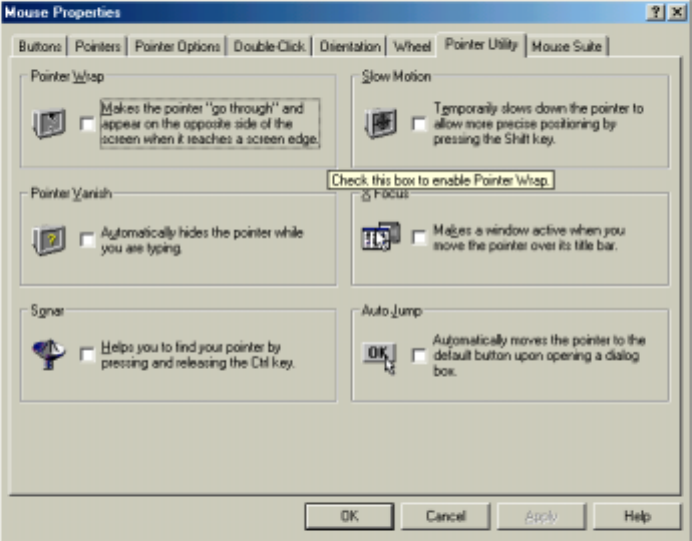
- 11 -
Pointer Utility
Opening the Pointer Utility page allows access to Pointer Wrap, Pointer Vanish, Sonar,
Slow Motion, X Focus and Auto Jump functions.
• To enable Pointer Utility functions, check on the desired function(s) and click on Apply.
Pointer Wrap
When the pointer reaches the edge of the screen, it will automatically go through and appear on
the other side.
Pointer Vanish
When Pointer Vanish is enabled, the pointer will be conveniently hidden from view while you are
typing text. The pointer will automatically reappear when your mouse is used again.
Sonar
Helps you to locate your pointer if you are having difficulty finding it. Press and release the Ctrl
key to activate the Sonar function. This function does not interfere with other Ctrl key functions.
Slow Motion
Allows you to temporarily slow down the pointer movement for precise positioning by pressing and
holding the Shift key. This function does not interfere with other Shift key functions.
X Focus
Activates an open window simply by moving the pointer over its title bar. This function is useful if
you want to alternate between several open windows without clicking.
Auto Jump
The pointer will automatically appear on the default button (e.g. OK) whenever a dialog box is
opened.
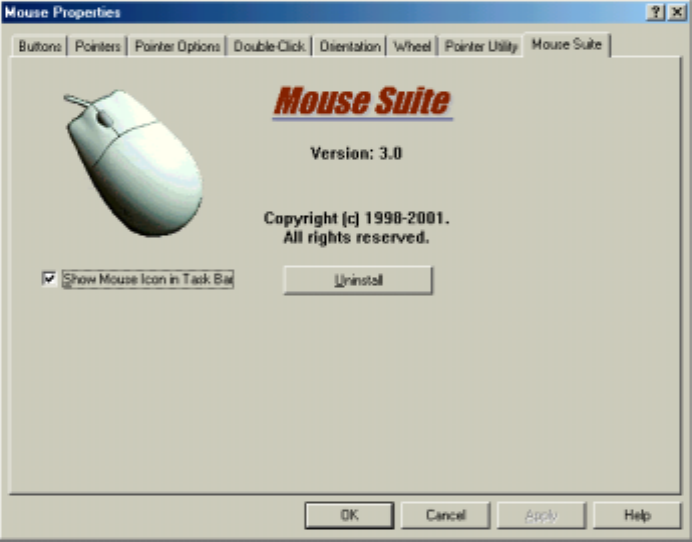
- 12 -
Mouse Suite™
The Mouse Suite™ tab provides the miscellaneous information about the Mouse Suite™
software, a link to our web site for online product support as well as an uninstall utility
and a Task Bar Mouse Icon option.
Uninstall
• To uninstall Mouse Suite ™, click on the Uninstall button and follow the on-screen
instructions.
Task Bar Mouse Icon
• To add the Mouse Suite™ Icon to the Windows Task Bar, click on Show Mouse Icon in Task
Bar, then click on Apply.

- 13 -
Troubleshooting
Reviewing the following section may help you diagnose any problems you are having
with the operation or installation of your new mouse. If the problem you are experiencing
is not referred to below, or the suggested solutions do not solve the problem, please
contact our Technical Support staff.
• Why isn’t my pointer moving smoothly?
Your mouse ball and ball cage may require cleaning. Refer to the Maintenance section for
proper cleaning procedures.
• Why isn’t the pointer responding to my mouse movement?
Your mouse is not being properly detected.
Make sure your mouse cable is connected properly to the correct port prior to installing
Mouse Suite ™software.
Your serial or PS/2 port may be improperly configured (refer to your computer’s
documentation for proper configuration).
The IRQ/address settings of other system devices (e.g. modem card) may be in conflict
with your mouse’s settings. Check the IRQ/address settings for conflicts, and change
them if required.
• Why aren’t the wheel functions of my PS/2 mouse working with my notebook?
On your notebook, you may need to disable the trackball or touchpad in the BIOS and enable
the external PS/2 mouse port in order to successfully use all of your mouse’s functions.

- 14 -
Maintenance
If the pointer skips or move abnormally, clean the ball of your mouse by following these
steps:
1. Remove the retainer ring to remove the ball.
2. Wipe the ball with a clean, lint-free cloth, and then blow carefully into the ball-cage to dislodge
dust and lint.
3. If the rollers are dirty, clean the rollers using a cotton swab moistened lightly with isopropyl
(rubbing alcohol). After cleaning, make sure the rollers are still centered in their channels.
Make sure that fluff from the swab is not left on the rollers.
4. Replace the ball and retainer ring.

- 15 -
Technical Support
If you are experiencing difficulty with the installation or use of our product, please contact
our Technical Support staff. We will be more than happy to assist you with any problems
you may have.
Contact us by Email:
Help@mail.primax.com.tw
Visit our Website:
http://www.primaxelec.com